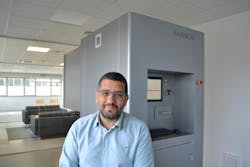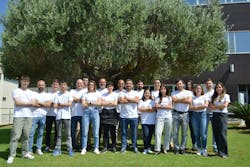FYLA grows to meet industry’s ultrafast laser needs
As a child, Pere Perez-Millan loved nature—especially astronomy—and wanted to understand the world from a scientific point of view. It led him to an undergraduate degree and Ph.D. in physics from the University of Valencia and the creation of FYLA, a company that specializes in ultrafast lasers and systems for scientific and industrial applications. It’s no surprise that nature still plays a role in Perez-Millan’s outlook, the philosophy of his company, and his lasers’ practical applications.
From scholar to entrepreneur in Valencia photonics ecosystem
Perez-Millan’s decision to study at the University of Valencia was instrumental to his future success. After acquiring both his undergraduate degree and Ph.D., he became a research fellow in the Nanophotonics Technology Centre of the Polytechnic University of Valencia. During this time, Perez-Millan set up and led a team of engineers and physicists to develop a mode-locked laser that he now describes as the seed from which FYLA grew.
Perez-Millan was asked to develop a specific application that would build on the optical fiber laser he developed during his Ph.D. work—taking one that was leveraged for Q-switched lasers and applying it to mode-locked lasers. This challenge made Perez-Millan fall in love with mode-locked lasers. He recalls recognizing that mode-locked lasers are beautiful, and his realization that he could feel the harmony of nature in them.
He remembers the day he first achieved success: It was the noise he noticed first. Modes in the spectrum analyzer were noisy but suddenly everything locked and still lines of the comb appeared—it was a true moment of amazement.
Perez-Millan continued investigations into mode-locked lasers, and his tutelage under Professor Miguel V. Andrés at the University of Valencia pushed him to find practical uses for his findings and not simply research and publish. It motivated him and brought out his entrepreneurial spirit.
While he worked on mode-locked lasers at the Nanophotonics Technology Centre of the Polytechnic University of Valencia, partners at the Fiber Optics Group of the University of Valencia were evolving—separately—the design and manufacturing of photonic crystal fibers. This simultaneous work turned out to be critical to his next step: Merging the two technologies led to work on a supercontinuum laser that could be competitive within the industry.
Perez-Millan took a leap forward and developed a supercontinuum prototype to debut at the Laser World of Photonics exhibition in 2013. Fortuitously, Ramon Sans, R&D director of Jeanologia, a Spanish company that specializes in laser applications within the textile industry, was at the conference and appreciated not only how great the laser technology was but its potential to solve industrial problems. Convinced by Sans, Enrique Silla, CEO of Jeanologia, was the first to invest in Perez-Millan and gave him the seed money he needed to officially launch FYLA in 2014.
The middle years come full circle
After FYLA’s launch, Perez-Millan, with a belief that the team is the core of the company, recruited industry leaders with complementary skillsets to work on ultrafast fiber lasers. He saw and continues to see FYLA’s products like a tree: They start from a single seed or source and, through the use of different types of amplifiers and fibers, different products emerge.
The first time the company evolved, they developed high-power femtosecond fiber lasers for applications in manufacturing, the semiconductor industry, the textile industry, and even the pharmaceutical industry. These lasers with ultrashort pulses of light offered the precision necessary for materials processing, spectroscopy, biomedical imaging, and scientific research applications.
Today, FYLA’s solutions are advanced light sources that generate a broad spectrum of wavelengths from ultraviolet to infrared and are used for applications in spectroscopy, bioimaging, telecommunications, and materials processing. FYLA’s ultrafast lasers also enable multiple experiments crucial to astrophysics—from wavefront sensing capabilities to the characterization of optical instruments and alignment measurements.
The seedling sprouts again
In 2018, venture capital firm Bullnet Capital joined FYLA to boost its growth. Bullnet was backed up later by CDTI Innvierte. The very first seed of the company, mode-locked lasers, is sprouting again—in two directions. First, still in a nascent stage, is free space optics. Second, FYLA is expanding into whole systems development. Recognizing pain points of laser applications across fields, FYLA pivoted to explore how they could design whole systems for specific industries.
This second avenue meant FYLA had to define a narrow focus and niche by defining sectors where they can solve bottlenecks. For example, they’re addressing inspection systems for quality manufacturing. FYLA’s product Rainbow inspects, measures, and calibrates color properties in real time. It’s useful for inspecting coil coating and helps eliminate losses due to noncompliance in manufacturing.
Words of wisdom
Perez-Millan’s advice to future photonics leaders is: “Have clear motivation.” Understanding your motivation—and what your motivation is not—drives your decisions and business forward. He also says be honest about working toward your vision of success—whether it’s money, status, or making an impact on the world.
Perez-Millan also encourages any entrepreneur within the photonics industry to take the time to build a strong, complementary, and motivated team, because there is nothing more important than the team. Have patience that investors will come if the product is strong (have a long-term plan), and don’t give failures more importance than necessary. Any entrepreneur must recognize that failure is simply part of business.
As he looks ahead, Perez-Millan says the company has much to look forward to as business continues to grow. For him, it’s about shooting for the stars and finding the natural fit.
About the Author
Jose Pozo
Chief Technology Officer, Optica
Jose Pozo joined Optica in March 2022, and has spent more than 25 years working in photonics. He earned a PhD in quantum physics from the University of Bristol (U.K.), and an M.Sc. and B.Eng. in telecom engineering from UPNA, Spain / VUB (Belgium). Prior to joining the European Photonics Industry Consortium (EPIC) in 2015 as CTO, Jose was a Senior Photonics Technology Consultant with PNO Consultants, with some of the main accounts such as CERN, Thales, and TE Connectivity. He has worked at TNO, The Netherlands Organization for Applied Scientific Research, and as a postdoctoral researcher at the Eindhoven University of Technology in the Netherlands, where he contributed to the early development of EFFECT Photonics.

